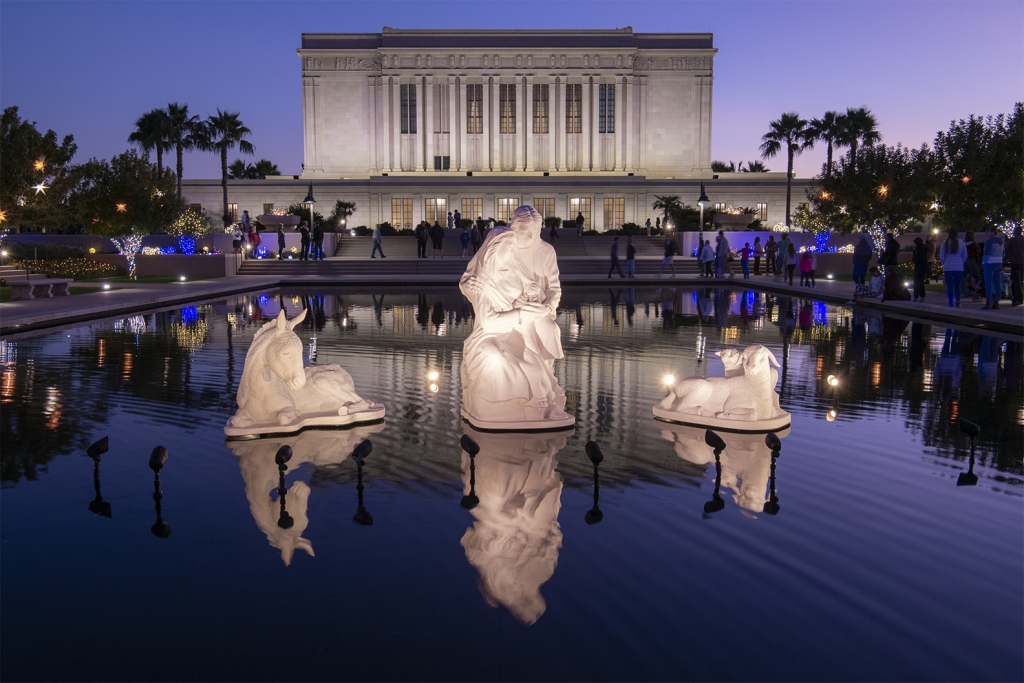Nativity Narratives

Writer Joseph J. Airdo // Photography Courtesy of Mesa Temple
Between the bright lights, pretty wrapping paper and various forms of evergreens that adorn our homes each Christmas, there is one piece of decor that is often the most cherished.
Whether passed down through generations or purchased as a reflection of one’s faith, the nativity is a meaningful reminder of not only the reason for the season but also who we are, where we come from, what we value and what we believe.
Mesa Temple Visitors’ Center this month hosts a display that features more than 100 nativities from around the world — each one an inspiring work of art that depicts the birth of Jesus Christ and communicates a narrative about its country or culture of origin.
The exhibition is part of Mesa Temple’s annual holiday celebration, which began more than four decades ago with a small light display that has since grown to become one of the largest Christmas lighting events in the Southwest.
In 1979, temple president L. Harold Wright envisioned that lighting the temple grounds at Christmastime could be a “gift to the community.” That year, 5,000 clear and blue lights were hung around the temple’s visitors’ center roof and reflecting pool, where electrical outlets were available.
In 1985, when a new sprinkler system was installed, underground electrical lines were added to make more outlets available and lights were able to be placed throughout the temple’s gardens. At this time, “Good Morning America” named Mesa Temple’s celebration one of the top three “must-see” holiday lighting extravaganzas in the United States.



Music was added, with local school and church choirs and private ensembles representing a variety of cultures and musical styles performing nightly concerts during the celebration. By the early 1990s, more than 300,000 lights adorned the temple grounds as chartered buses filled with visitors from around the Valley congregated at the temple to witness the display.
Stacey Farr, who has served as director of Mesa Temple’s holiday celebration since 2015, says that the international nativity display was introduced about 20 years ago as a natural evolution of the temple’s mission to invite all people to feel the spirit of Christmas.
“The lights that we put on the grounds emulate the light of Christ,” says Farr, noting that roughly 3,000 volunteers build, facilitate, set up and take down the sprawling 12-acre light display each holiday season. “The nativities signify this grand miracle because, without His birth, we would not have had His resurrection. And without His resurrection, we would not have Christmas.”
Over the years, community members and groups have donated about 400 nativities — many of which are handmade — to the temple. They come from all over the world, with volunteers ensuring that there is at least one nativity that represents the country or culture of each of Mesa Temple’s sister missionaries — young women who are serving full-time proselyting missions for The Church of Jesus Christ of Latter-day Saints.
“There are some from different Native American tribes that are just unbelievably creative,” says Farr, noting that visitors who are familiar with Hopi and Navajo designs, textures and patterns will immediately recognize the nativities of those tribes.
Mediums include wood, copper, porcelain, metal, fabric, resin, stained glass, paper and a variety of natural items that reflect the art, practices and traditions of people around the world.
“There is one that is made of chewing gum wrappers and another that is made of seeds and nuts,” Farr says. “We even have one that is made out of woven grass. The creativity is just phenomenal. We have one from Wisconsin that is made entirely of beeswax. It smells like honey. It is absolutely awesome.”



One sister missionary came to Mesa Temple from a country whose only nativity was represented on a stamp. Therefore, that stamp has been added to the display.
“The craftsmanship is stunning,” Farr adds. “Some feature miniatures that are less than an inch tall and have been beautifully crafted with so much intricate detail. There is also one that is extremely heavy because it is made of cast iron and magnets.”
With 400 nativities in its collection and limited space to display them, volunteers select about one-quarter of the nativities in rotation to showcase each season. Therefore, a visitor who attends the exhibit one year will certainly see several new nativities the next.
This year’s display features several other surprises, as well — including a number of large-scale outdoor nativities, trees decorated with elegant ornaments and historical pictures of the temple, a long piece of upstairs artwork on which angels appear and QR codes linking to special videos that enhance and expand each visitor’s experience.
“There is also a nativity that sits in the reflection pool in front of the temple that is absolutely stunning because it looks as though it is just floating on water,” Farr says.
“All of our displays as well as our lights are not done in a style that is flashy or anything like that. It is calm, peaceful and serene. We just want people to come and feel peace through the light of Christ and, when they leave, to feel joy. That is our goal.
“Mesa Temple is a very sacred place and we have volunteers and visitors from all walks of life, all faiths and all ages. Everybody just wants to be a part of this. It is so beautiful. People come from all over the world to experience this, and every single one finds something that touches, moves or inspires them.”
Mesa Temple International Nativity Display
Through Dec. 31 // Nightly 5–10 p.m. // Tuesdays and Thursdays 11 a.m.–1 p.m. // Mesa Temple Visitors’ Center // 455 E. Main St., Mesa // Free // 480-964-7164 // mesatemple.org

